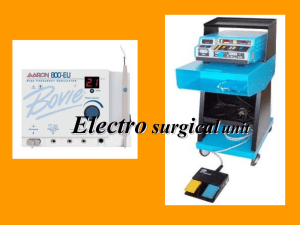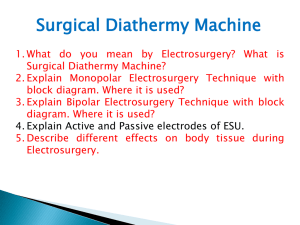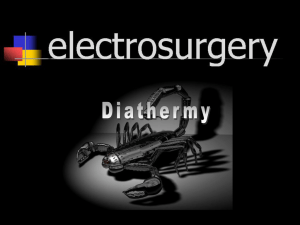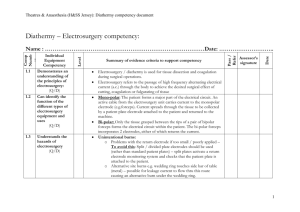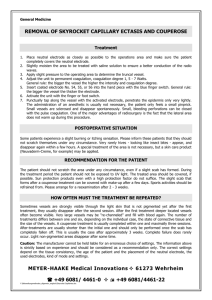UNDERSTANDING ELECTROSURGERY
advertisement
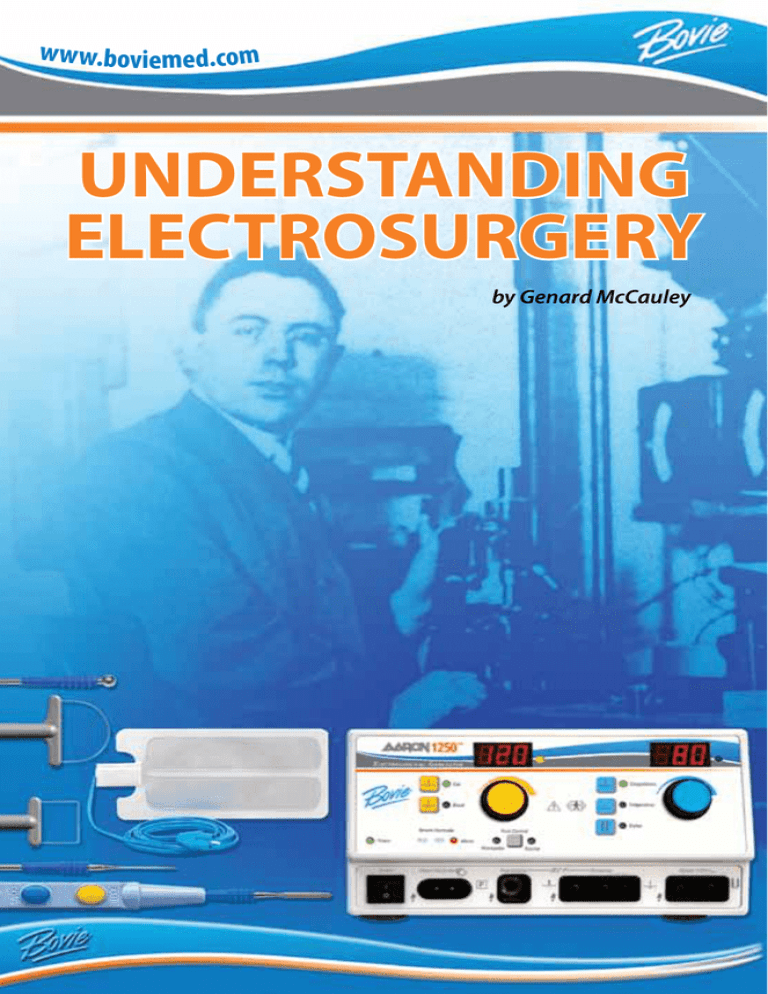
www.boviemed.com Understanding Electrosurgery by Genard McCauley © Copyright 2010, Bovie Medical Corporation Clearwater, FL. This publication may not be reprinted or distributed in part or in whole, by any means, whether electronic or hard copy, without the express written permission of Bovie Medical Corporation. Table of Contents Why should electrosurgery be important to you?.......................................4 Overview............................................................................................................4 Objectives..........................................................................................................4 Electrosurgery Market......................................................................................4 History................................................................................................................5 Purpose of Electrosurgical Units (ESU’s).......................................................6 Principles of Operation....................................................................................6 Monopolar Electrosurgery.......................................................................6 Bipolar Electrosurgery..............................................................................7 Dispersive Electrodes................................................................................7 Terms..................................................................................................................8 Current Density..........................................................................................8 Isolated Power System..............................................................................9 Discrete vs. Non-Discrete.........................................................................9 Cut...............................................................................................................9 Blended Cut..............................................................................................10 Coagulation..............................................................................................10 Coagulation (Pinpoint)...........................................................................11 Fulguration (Spray).................................................................................11 Electrosurgical Safety.....................................................................................12 3 Why should electrosurgery be important to you? Electrosurgery is used in 80% or more of all surgical procedures. In addition, with so many procedures being done in an outpatient environment today, this is an expanding opportunity. Overview This booklet is intended to introduce the medical sales professional to the world of electrosurgery. The information imparted here will also serve as a reminder to the more seasoned sales professional. This information should be used as a guide to growing the necessary knowledge and confidence needed in the highly technical market of electrosurgery. Objectives • Describe the principles, history, and modalities of electrosurgery • Touch on the evolution of electrosurgery • Briefly discuss the market of electrosurgery • Discuss the risks involved in the use of electrosurgery • Give an understanding of the terms used in connection with electrosurgery Electrosurgery Market With the changes in the medical field over the last decade, a larger percentage of surgical procedures are moving out of the traditional operating room into Dr.’s offices and clinics. Although the opportunities are still huge in the hospital arena, this area can be time consuming and very specification restrictive. The areas of clinics and Dr.’s offices provide opportunities to build relationships by providing top quality, state of the art equipment at affordable pricing. The areas of, Dermatology, Plastic Surgery, Gynecology, Ophthalmology, Urology, Otolaryngology, Dental, and lets not forget about the Family Practice and the Veterinary arena, are just a few that require the use of electrosurgery. Virtually every Dr.’s office is a potential customer. The key here is to provide the Dr. with the correct unit for his needs. The qualifying question to your potential customers is, “Dr., do you use the Cut mode?” With that question out of the way it should be easy to provide the Dr. with the proper electrosurgical unit for his needs. 4 History Most surgeons the world over refer to their electrosurgical equipment or accessories as their “Bovie”. This is because electrosurgery originated with Dr. William T. Bovie. Dr. Bovie received his PhD from Harvard and worked there from 1914 – 1927. Bovie, along with Neurosurgeon, Harvey W. Cushing, M.D., is credited with inventing the electrosurgical unit known today as the “Bovie”. The first use of the electrosurgical generator in an operating room was on October 1, 1926, at Peter Bent, Brigham Hospital in Boston, Massachusetts. A Dr. William T. Bovie few days earlier (September 28, 1926) Dr. Cushing had been unsuccessful in removing a mass from a patient’s head due to its highly vascular nature. In Dr. Cushing’s notes from October 1st he wrote, “…with Dr. Bovie’s help I proceeded to take off most satisfactorily the remaining portion of tumor with practically none of the bleeding which was occasioned in the preceding operation.” Seventy-five years later, we continue to work on improving the work of Dr. Bovie. Amazingly enough except for the high advancements in the electronic technology, the advancements of electrosurgery are relatively few. Again, except for electronic advancements, the advancements in electrosurgery can be chronologically listed as follows: • 1980’s, the improvement from ground reference to isolated units • 1980’s, the improvement to discrete output units •1980’s, the improvement of tissue impedance monitoring at the patient plate • 1987, the introduction of argon gas enhanced coagulation • 1990’s, the introduction of tissue response at the active electrode The work at Bovie/Aaron continues today to improve the performance of electrosurgery, but our sincere thanks go out to Dr. Cushing and William T. Bovie for their incredible invention. 5 Purpose of Electrosurgical Units (ESU’s) ESU’s are used for surgical cutting or to control bleeding by causing coagulation (hemostasis) at the surgical site. They deliver high-frequency electrical currents and voltages through an active electrode, causing desiccation, vaporization, or charring of the target tissue. ESU’s are a useful tool in all aspects of the surgical arena: from the most basic wart removal, spider veins, or hair removal in a doctor’s office; to the most intricate open heart, orthopedic, and transplant procedures. An ESU, by definition, is a generator capable of producing a cutting and/or coagulating clinical effect on tissue by the use of alternating current at a high frequency (RF - radio frequency, also known as radio surgery). Voltages and currents may vary depending on the desired clinical effect. The Aaron 1250™ Principles of Operation Monopolar Electrosurgery In monopolar electrosurgery, tissue is cut and coagulated by completing an electrical circuit that includes a high-frequency oscillator and amplifiers within the ESU, the patient plate, the connecting cables, and the electrodes. In most applications, electric current from the ESU is conducted through the surgical site with an active cable and 6 Monopolar Handpiece Receptacle on A1250™ electrode. The electrosurgical current is then dispersed through the patient to a return electrode returning the energy to the generator to complete the path. Monopolar electrosurgery has the means of delivering energy to the tissue through several modalities (modes of operation): pure cut, blended cut, desiccation (or pinpoint), and spray (or fulguration). The delivery system of the monopolar electrosurgical generator can be a hand controlled pencil (reusable or disposable) or a foot controlled pencil. A number of accessories can be adapted to the foot control output jack to deliver energy through a number of instruments. Bipolar Electrosurgery In bipolar electrosurgery, two electrodes (generally the tips of a pair forceps or scissors) serve as the equivalent of the active and dispersive leads in the monopolar mode. Bipolar electrosurgery does ™ not require a patient plate. Electrosurgical current A1250 Bipolar Mode Selector in the patient is restricted to a small volume of tissue in the immediate region of application of the forceps. This affords greater control over the area to be coagulated. Damage to sensitive tissues in close proximity to the instrument can be avoided. There is less chance of current capacitively or directly arcing to surrounding structures such as the bowel. Patient burns are virtually eliminated. Dispersive Electrodes A dispersive electrode is an electrode with a relatively large surface area which is positioned on the patient in order to A1202 Solid Pad allow the high frequency current to flow back with a low current intensity in order to prevent any physical effects, such as undesired burns. ESRE Split Pad Over the years electrosurgery has advanced, so too have the types and styles of dispersive electrodes. Early on in electrosurgery the only choice was a solid pad (at first a stainless steel plate) that was placed on the patient to disperse the heat of the RF energy. If the solid plate was not applied correctly or began to move off the patient during the case, the ESU would continue to deliver energy to the tissue, causing a potentially dangerous situation. Advancements in technology developed the ability to sense the tissue impedance at the patient plate (NEM - Neutral Electrode Monitoring). If the patient plate is not applied 7 correctly or if the patient plate begins to come off during the case, the ESU will discontinue to deliver energy and sound an audio alarm to alert the medical staff. TERMS Current Density Electrosurgery makes use of an intensely concentrated current to induce a heat energy that is capable of a range of effects: from the drying out of cells – with consequent coagulation of blood, to the vaporization of cells – permitting an electrode to physically separate a path through living tissue. The degree of current concentration is called “current density.” Current density is one of the most important concepts in electrosurgery. Simply stated, current density is the amount of current concentration at a given point. In electrosurgery all of the RF current is forced to flow through the tiny area where the active electrode makes contact with the skin. At this point, the current flow is concentrated intensely. The heat at the site is great enough to achieve cutting and coagulation. ES01 Standard Blade Electrode Current leaves the body via a dispersive electrode (grounding pad). The pad has a large surface area thus the current density is quite low. As long as this large, so-called “dispersive” electrode makes good contact with the skin it should offer a passage of least resistance for safe exit of the RF current from the patient. The large surface area generates little Split Grounding Pad heat, thanks to the low current density. A generator with Cord supplies RF to the active electrode. Current passes through the patient, exiting by way of the return electrode. It returns to the generator to complete the circuit. Without complete circular path, from generator to patient, back to the generator, the current should not flow. Return Electrode Cord Receptacle 8 Isolated Power System An isolated power system utilizes a transformer to isolate power with no voltage reference to ground. This is an important safety feature because it reduces the risk of alternate path burns. It is symbolized on the unit by an “F” in a box. Discrete vs. Non-Discrete There are two ways in which a unit can deliver its RF current: discrete or nondiscrete. Discrete output means that while several active instruments may be attached to the ESU only one accessory may be activated at a time. The RF current will flow only through the one accessory on a “first come, first served” basis. This is a safety factor of major importance to the surgical staff. Some units are equipped with non-discrete output. When an accessory is activated any and all accessories connected to the unit are also activated. This means that care must be taken to isolate all additional accessories from the operative sight. Usually a safety cup, holster, or other similar device is used. Some manufacturers have developed what is known as “discrete output – simultaneous on demand” capabilities. These units are still truly discrete as power is delivered on a “first come, first served basis,” however, power may be shared in certain instances. Two surgeons may activate simultaneously in the same mode (cutting or coagulation) and power is shared between the two active electrodes. Keeping in mind that electricity will follow the path of least resistance. The current will split unevenly between the two active electrodes, with the majority of current flowing to the less impedance, more delicate tissue, and less current flowing to the more difficult, higher impedance tissue. Whenever one surgeon ceases activation, the other surgeon once again receives full power. Cut The first clinical mode of a modern ESU is cutting. The unit offers the surgeon two types of cutting: pure cut and blended cut. Pure cut is used for dissection only. Blended cut adds some hemostatic effect. In pure cut the instrument performs much like Cut Mode Controls on Aaron 1250™ a stainless steel scalpel, in that the surgeon has little or no control over bleeding. There are, however, some notable differences. 9 One, the cutting effect of an electrosurgical instrument results from the heat of a current passing through tissue. Thus, it is the current that parts the tissue and not the instrument. The parting of tissue actually precedes the leading edge of the active electrode by a microscopic distance. Cutting is virtually effortless, so the surgeon may direct most of his attention to guiding the instrument. He need not apply as much pressure as he must with a scalpel. Two, however sharp it may appear, a stainless steel scalpel requires pressure and some effort in making the incision. In contrast, the electrosurgical instrument makes sharply defined incisions with relative ease. By adjusting the power to the desired level, the active electrode encounters little resistance to its passage through tissue. Blended Cut In addition to the pure cut, most ESU’s today offer a blended cut. The term “blended” does not refer to a blend of currents, but rather a blend of surgical effects. The blended cut permits the surgeon to cut Blend Mode Selector on and coagulate at the same time. In a pure cut the heat Aaron 1250™ energy is so great that cells vaporize. But in a blended cut, cooling periods slow down the action to a dehydrating crawl. Cell wall explosion and vaporization are replaced by the slow dehydration of cellular fluid and protein. This stops the bleeding at the moment the cuts are actually being made. By adjusting the blend the surgeon can get varying degrees of hemostasis. A blended cut is ideal for sealing off small bleeders when cutting through soft tissue. It is also used to resect masses of tissue and to reduce and recontour redundant tissue where the cutting is continuous, but the surgeon wishes to minimize bleeding and work in a clear field. Coagulation The second clinical mode of electrosurgical units is coagulation. There are two types of coagulation: Coagulation (also known as pinpoint)and Fulguration (also referred to as spray). They differ primarily in how they are applied. To apply pinpoint coagulation, the surgeon holds the electrode in physical contact with or against the tissue. 10 Coag Mode Controls on Aaron 1250™ When fulgurating, the surgeon holds the electrode some distance awayfrom the tissue and the RF current is delivered to tissue by way of sparks jumping cross the airspace contacting the tissue. Coagulation (Pinpoint) Factors affecting pinpoint coagulation include; current density, period of contact, and surgical technique. Therefore, when using pinpoint coagulation the time that the electrode remains Coagulation Mode Selector in contact with the tissue is important. The tip on Aaron 1250™ should make only light, momentary contact with the surface. Power should be adequate to deliver a desired clinical effect. The desired effect for pinpoint coagulation is to stop local bleeding. Here, an interrupted current supplies controlled dehydration. The drying out effects of a pure coagulating current produce a zone of coagulation necrosis that is limited to the surface layers of the tissue. Fulguration (Spray) Fulguration is another type of coagulation. Fulguration can be defined as non-contact coagulation in which current sparks or jumps from the active electrode to the tissue. Fulguration Mode Selector on Aaron 1250™ Not only is fulguration an important electrosurgical modality for sealing off small hidden bleeders which surgeons have difficulty locating, fulguration is especially useful for those areas with large bleeders. Many surgeons use spray coagulation to destroy the surface layers of cells in the bed from which a suspicious lesion has been removed, to prevent possible migration of malignant cells. Good technique helps avoid charring. The secret is to keep the electrode moving at all times. This prevents the build up of heat in one area. Usually, the surgeon moves the electrode over the areas to be treated just long enough to dehydrate the surface which forms an even and pliable eschar. The ideal effect is coagulation without a blackened eschar. 11 ELECTROSURGICAL SAFETY Electrosurgical safety measures are intended to minimize the potential for electrical and other hazards before, during and after procedures that involve the therapeutic application of RF energy. The two most common hazards associated with the use of any electrosurgical device are explosion/fire and burns. Electrosurgery can also interfere with other electromedical devices or produce a noxious smoke with, as yet, undefined harmful effects. Explosion and fire can occur if electrical sparks ignite flammable gases or solutions. Although, fire hazards have been greatly reduced over the years, lack of appropriate safety measures are still causes for concern. Most flammable anesthetic gases have been eliminated from the operating room; alcohol preps and other flammable vapors can ignite if present when an active electrode is used in the same area. Inadvertent activation of an active electrode positioned on sponges, drapes, or in an oxygen-enriched atmosphere can result in fires. Unintended burns are the least understood and most dangerous hazards in surgery. A patient may be burned in three ways: • intended burns at the active electrode site • unintended burns at the active electrode site (direct coupling) • unintended burns at an alternate site (capacitive coupling) Alternate path burns are all but eliminated with the design of the isolated units of today. Ground reference units, which are still in the surgery arena, were prone to this type of burn if the patient were touching a grounded area or if the pad were not placed on the patient. In cases like this the energy would find ground through the easiest means possible. With isolated units, if the energy does not find its way to the dispersive electrode the unit will stop delivering energy. Capacitive coupling is defined as the establishment of currents between two conductors that are separated by an insulator. In electrosurgery, the phenomenon of capacitive coupling between an insulated electrode and a surrounding metal trocar with plastic screw threads is a possible example of an inadvertent injury. 12 Direct coupling is defined as intended or unintended contact between active electrode and tissue. Unintended direct coupling may occur due to faulty insulation on an active electrode which can be the result of continual reprocessing or deterioration caused by normal wear and tear of instruments. Direct coupling caused by insulation breakdown is potentially more devastating than capacitive coupling The Association of Operation Room Nurses (AORN) recommends the use of a smoke evacuation system to protect operating room staff from inhaling the smoke generated during electrosurgery procedures. AORN cites the potential for bacterial and viral contamination of the smoke and warns that gaseous by-products can be toxic and mutagenic. Although the above-mentioned safety hazards exist, and are all inherent to the use of electrosurgery, they are all controllable hazards. Through ongoing education to personnel these hazards can be eliminated. Education should include the principles of electrosurgery and proper operation, care, and handling of the specific electrosurgical equipment used in the practice setting. The most effective safety system in electrosurgery is a knowledgeable doctor, nurse, and sales force. A basic understanding of electrosurgery and adherence to the necessary precautions will assure a safe environment for both patient and staff. 13 Notes 14 Notes 15 Bovie Medical Corporation 5115 Ulmerton Road • Clearwater, FL 33760 Ph 1-800-537-2790 • Fax 1-727-347-9144 sales@boviemed.com • www.boviemed.com MC-55-049-001 Rev.2
